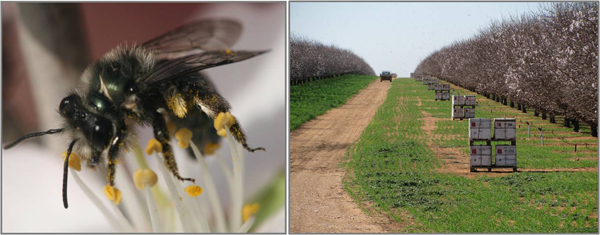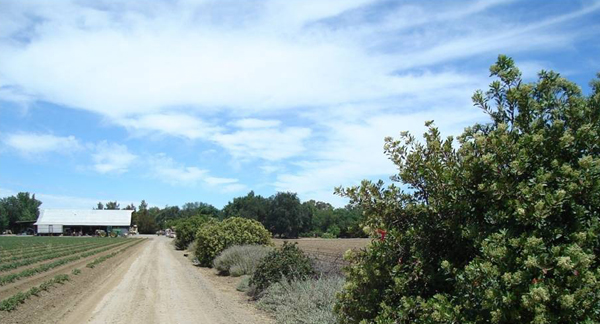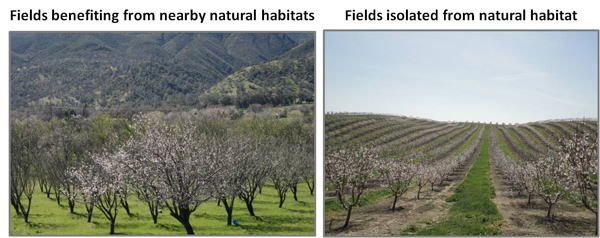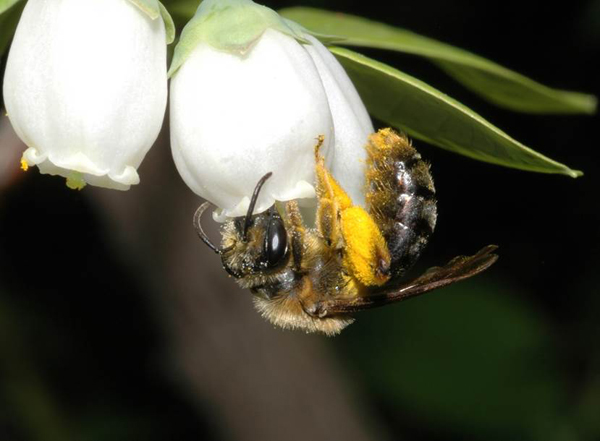Bees may seem like uninvited guests at your picnic – but before you shoo them away from the fruit salad, think twice, as they play a critical role in making your picnic possible.
Some of the most healthful, picnic favorites – including blueberries, strawberries, cantaloupe, watermelon, cucumber, avocados and almonds – would not make it to the table without the essential work by bees and other insects.
Most crops depend on pollinating insects to produce seeds or fruits. In fact, about three-quarters of global food cropsrequire insect pollination to thrive; one-third of our calories and the majority of critical micronutrients, such as vitamins A, C and E, come from animal-pollinated food crops.

To provide pollination services to such crops, farmers often rely on domesticated honey bees. But with the decline of honey bee colonies due to diseases and pesticides, this single-management strategy is increasingly risky. Moreover, a recent study in the journal Science, led by Lucas A. Garibaldi (at the National University of Rio Negro in Argentina) involving me and 48 other scientists, indicates that reliance on a single domesticated species is not only risky, but also inefficient.
Based on a synthesis of 600 fields at 41 crop systems, we found that wild bees and insects were more effective at pollinating than managed honey bees, even doubling the proportion of flowers that develop into mature fruits or seeds. In fact, the proportion of flowers that matured to fruit improved in every field visited by wild insects, compared with only 14% of fields visited by honeybees. This means that rented honey bees supplement, rather than replace, critical yet free pollination services provided by wild bees to crops.

This is a big deal. As the world population is estimated to increase to nine billion by 2050, with a corresponding need to double the global food supply, we must find ways to make more food from the same amount of land. And our research suggests that to achieve such “sustainable intensification” we should secure healthy populations of wild pollinators across agricultural landscapes worldwide. But given dramatic declines in many bee species globally, this presents a daunting yet timely challenge.
A major driver behind the decline of wild pollinatorsis the loss and degradation of natural habitats. Simultaneously, farm management practices have been implicated. To better understand these different factors, Claire Kremen (at University of California, Berkeley), Eric Lonsdorf (previously at the Lincoln Park Zoo, Chicago), and I worked with an international team of bee biologists and synthesized data on wild bee communities in agro-ecosystems from around the globe (including 39 studies on 23 crops in 14 countries and 6 continents).
We found that wild bee assemblages were most diverse and abundant on fields managed organically and that grew a variety of crops or had natural vegetation like hedgerows, flower margins, and live fences (as recently published in Ecology Letters).

Our results suggest that switching from conventional to organic farming could lead to an average increase in wild bee abundance and richness by 74% and 50%, respectively, and enhancing field diversity could lead to an average 76% increase in bee abundance. Farmers can therefore maximize pollination services to their crops by reducing their usage of bee-toxic pesticides and herbicides, planting small fields of different flowering crops, increasing the use of mass-flowering crops in rotations and breaking up crop monocultures with hedgerows and other natural vegetation.
In addition to local-scale field effects, we modeled landscape-level effects using a crop pollination model (available through the Natural Capital Project), and found that bees benefited when farms were surrounded by natural habitats, especially when in large monocultures;and that each 10% increase in the amount of high-quality bee habitats in a landscape leads to an average 37% increase in bee abundance and richness.

This is good news. This means we have multiple options to safeguard pollinators and their services to crops. We can protect and enhance natural areas around farms as well as improve on-farm management to benefit both our natural heritage and our agricultural harvests.
So if bees at a picnic may not sound like fun, believe me, you couldn’t have one without them.




The following appears to be inaccurate:
“In fact, about three-quarters of global food crops require insect pollination to thrive…”
Every source I’ve seen, including the link you’ve provided (see below), says it’s more like 35%.
“However, global production volumes give a contrasting perspective, since 60% of global production comes from crops that do not depend on animal pollination, 35% from crops that depend on pollinators, and 5% are unevaluated.”
Ironically, the bees you think are wild are really the domesticated bees doing all the work you think the wild bees are doing. Ban the domesticated bees from the fields, amd this problem will get worse.
I was a beekeeper for 16 years until year after year we had diseases, bees absconding & dying off from bad winters. THE BIGGEST DIE OFF THO,I THINK, WAS BECAUSE OUR GOVERNMENT MADE THE FARMERS PUT HERBICIDES & PESTACIDES ON OUR CONSUMABLE FOODS & OUR CATTLES FOOD ALSO SO IT WOULD LOOK MORE PERFECT & IT COULD BE WORTH MORE MONEY!
If the bees dissappear, in 5 years, we do also!
One additional comment. There are beekeepers who specialize in rescuing bees that have set up housekeeping in inappropriate places. Those beekeepers often need a place to put the rescued hive because if too many hives are located in the same place there is not enough forage within a reasonable distance to support the hives.
Those beekeepers are always looking for homeowners who will agree to have a hive in their yard. Those bees often do very well because homeowners keep flowers, often year round, and there is less competition with other hives.
So consider being a “foster parent” to a hive. You’ll get the pollination and usually part of the honey. And you’ll learn a lot about nature.
There is an issue with wild bees now that the Africanized bees are moving into the US. Africanized bees tend to replace European bees in the wild. For example, there are almost no wild European bees in South and Central America. And Africanized bees can be dangerous to people and animals.
Beekeepers are the main line of defense against Africanized bees. If they observe that one of their hives have converted to Africanized bees, they will replace the queen with a European queen.
Even in South America, beekeepers are learning to deal with the Africanized bees, selectively breeding towards less aggressive Africanized bees.
Wild bees sound nice, until you find that the hive is Africanized and has killed your family dog in a frenzied attack.
As a retired junior high science teacher, I am pleased to know how well wild bees can do the pollinating better than the domesticated bees and do it so well in acreage of organic crops, acreage of natural habitats. Remarkable !!!
I wonder if these facts are well-known here in Iowa and other vast farming areas ? Such information should be taught in all schools as children are are future and need to be of an informed future.
It’s time to get all teachers informed and involved. !!!!
very interesting and timely for me We’ve planted an extensive garden this year, and I’m encouraged to see the abundance of bees and other insects around the flowering vegetables. Hope to have bumper crop this year in part due to the work of the bees. Keep us informed on how to help improve the wild bee population